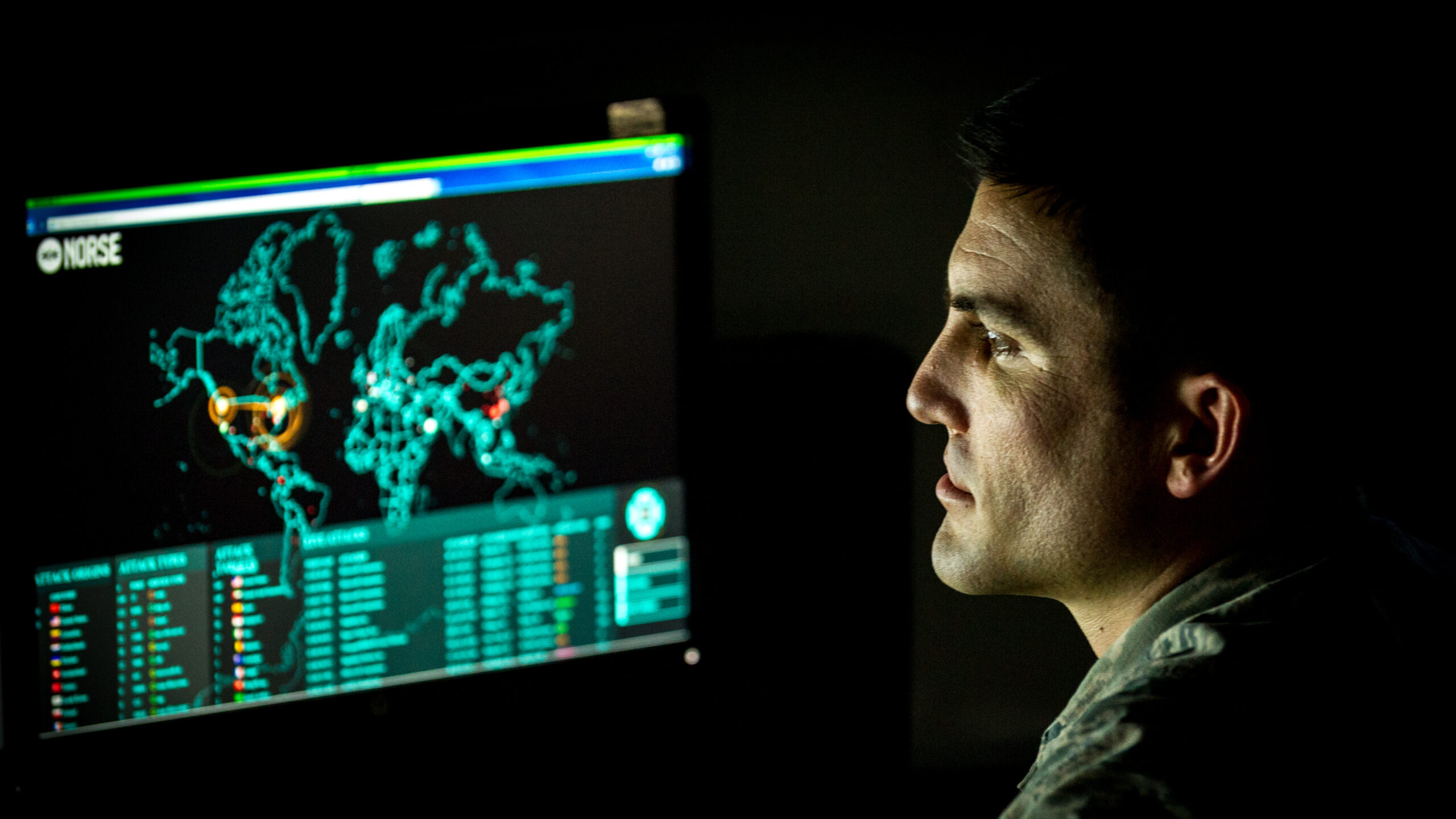
Staff Sgt. Wendell Myler, a cyber warfare operations journeyman, monitors live cyber attacks on the operations floor of the 27th Cyberspace Squadron, known as the Hunter’s Den, at Warfield Air National Guard Base, Middle River, Md., June 3, 2017. (U.S. Air Force photo by J.M. Eddins Jr.)
With the threat of China looming over everything the Pentagon does, the Special Competitive Studies Project (SCSP), a private foundation with ties to a number of well-known names in Washington defense circles, has launched a new report calling for changes in how the DoD interacts with technology. In the following op-ed, two of the authors of that report lay out the group’s findings.
It is time for the Pentagon to implement a new military-technological competitive strategy. The war in Ukraine has shown that the convergence of new technologies and operational concepts is creating new areas for competition and new opportunities to gain military advantage, threatening to make legacy approaches less relevant.
China’s People’s Liberation Army (PLA) has prepared for decades to exploit these changes in a potential confrontation with the US military. After the First Gulf War, the PLA determined that the Pentagon relies on an efficient command and control (C2) system, networked sensors, and precision munitions to win what the PLA calls “informatized warfare.” These capabilities give America a military edge, but come at the cost of centralization, which introduces glaring vulnerabilities. As a result, the PLA went about developing a theory of victory called system destruction warfare, which centered around degrading and deconstructing US C2 systems through a combination of electromagnetic, cyber, and kinetic attacks.
The good news, however, is that the US has a history of reorganizing to overcome challenges by ambitious rivals. At the outset of the Cold War, the Soviet Union had far more conventional military power in Europe than the allies. In response, the United States developed the First Offset Strategy, which created systems and trained personnel to keep bomber aircraft in the air at all times, empowered junior officers to man nuclear silos, and developed capabilities to stand watch on land, at sea, and below its surface.
While the United States was focused on the conflict in Vietnam, the Soviet Union reached nuclear parity and built a three to one conventional advantage over NATO forces in Europe. The US military responded by investing in the technologies, concepts, and training needed to develop a precision-guided munitions regime, known today as the Second Offset Strategy. By the mid-1980s, the Soviet Union realized the Second Offset left it without a viable route to military victory in Europe, which undoubtedly helped keep peace on the continent.
The Third Offset envisioned by former Deputy Defense Secretary Robert O. Work sought to organizationally shift the Defense Department from counterterrorism towards a technology-centric approach to great power competition and warfare. While it has yet to have the kind of impact of its predecessors, it did lay much of the intellectual groundwork for today’s defense technology initiatives — including what we propose must come next.
RELATED: Wittman: Why manned-unmanned teaming could be the Fourth Offset for America’s military
We now need a new offset strategy to reverse the erosion of the US military’s technological advantages, and to invalidate the PLA’s theory of victory. It must account for technology-driven changes to our and our adversaries’ ways of war. But unlike the previous offsets, we don’t have the luxury of time. It took the Soviet Union several years to replicate US nuclear capabilities; after the development of the Second Offset, it took even longer for other countries to build their own precision-guided munitions regimes.
Today, however, technology is advancing at an unprecedented speed, rendering capabilities outdated in just a few years. A combination of intellectual property theft and open-source publication of dual-use technologies is also disseminating technology across states exponentially faster than in earlier eras. In response the Special Competitive Studies Project has called for the development and implementation of a new military-technological competitive strategy: Offset-X.
Rooted in persistent asymmetries the United States can leverage against China, Offset-X outlines a path to close the immediate deterrence gap, while laying the groundwork for an adaptive force capable of perpetually deterring and outcompeting authoritarian rivals in a rapidly changing technology landscape. We can no longer gain lasting advantage from static capabilities.
To close the deterrence gap before 2027, the Department of Defense needs to identify gaps in the capabilities it needs to operate in the Indo-Pacific, and existing technology solutions the US military can adopt or acquire and rapidly scale. For instance, we advocate for the adoption of adaptive communication systems, such as NASA’s cognitive communications. Such systems use decision-making algorithms to determine the optimum path for signals to take in shifting, heterogeneous networks. As an example, a drone using adaptive communications, when jammed, would autonomously shift to communicating with the next most optimal node on its network, whether that’s a satellite, ship, or other drone. Adaptive communications would strengthen US power projection by fortifying C2 systems against disruption by the PLA.
The US military also needs a new technology-enabled force design to manage and adapt to longer-term challenges that will emerge in the evolving security environment. While the Department of Defense develops new capabilities prior to 2027, it must also design the future joint force to outperform and out-adapt the PLA in a protracted competition beyond the 2027 timeframe. We propose nine characteristics and sets of actions with near-term or medium-term impact for each that will collectively build the Future Joint Force we need.
For instance, the Future Joint Force must have equipment that is software-defined, updatable, interoperable, modular, and where possible, low-cost by design. To move the Joint Force towards this characteristic, the Department of Defense should develop and field a low-cost, software-centric version of a collaborative combat aircraft (CCA) to accelerate the delivery of much-needed capability while regularly improving the effectiveness of the platforms through software and other systems updates.
Certainly, other technologies will emerge that will impact US military planning. Offset-X, as we have laid it out, is not an end-all solution for the challenges. It is a starting point that we hope will drive the conversation forward. But the conversation needs to be underway.
Today, there is a growing realization that China is the challenge of our lifetimes. Yet, the magnitude and pace of our actions still do not reflect what is needed. Our military power has underwritten an international order that has fostered peace and prosperity on a scale that humanity has never before experienced. If we fail to move quickly to field next-generation capabilities and redesign the joint Force, the consequences could be dire. We could see a shift in the global balance of power, a direct threat to the peace and stability we have underwritten in the Indo-Pacific, and risk living in a world in which the Chinese Communist Party becomes the dominant power.
Transformation is never easy, but we have done it before, and as a result of bold action by our forebears, our country’s military power has secured an international order that has fostered peace and prosperity on a scale that humanity has never before experienced. Our political and defense leadership — and the American public — must again rise to meet this generational challenge and be the driving force behind the changes needed to defend the kind of world we live in today.
Justin Lynch is the SCSP Senior Director for Defense. Jung-Ju Lee is the SCSP Director for Defense.
Austin confirms ‘pause’ in bomb shipments to Israel
“We are assessing. We have not made any final decisions on this yet,” Defense Secretary Lloyd Austin said about a shipment of Boeing-made weapons to Israel. “But yes, there are some things we are taking a closer look at.”



























